Welcome to the ultimate guide on horse blankets! Discover everything you need to know about selecting, fitting, and maintaining blankets for your equine companion․ This comprehensive resource ensures your horse stays comfortable and protected in various weather conditions․
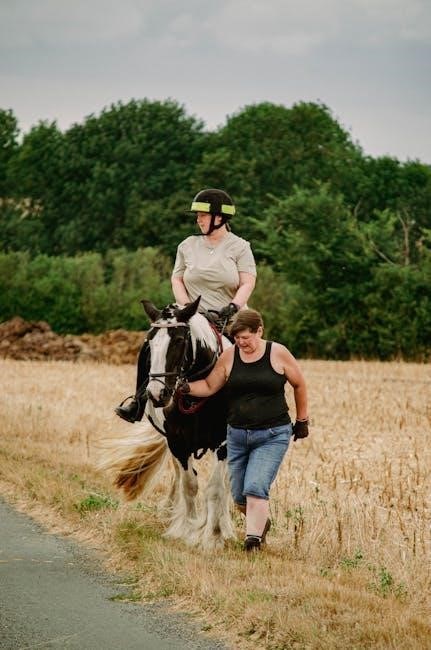
Horse blankets are essential pieces of equipment designed to protect horses from various weather conditions․ These blankets, tailored to fit the horse’s body, offer warmth, protection from rain and wind, and can significantly enhance a horse’s comfort․ Understanding the different types of blankets and their specific uses is crucial for responsible horse ownership․
Choosing the right blanket involves considering factors like living conditions, activity level, and climate․ A properly fitted blanket ensures comfort and prevents rubbing or discomfort, which are vital for the horse’s well-being․ Monitoring your horse and adjusting the blanket based on weather changes and the horse’s condition is also necessary․
Horse blankets come in various styles, including turnout blankets for outdoor use and stable blankets for indoor comfort․ Selecting the appropriate blanket type and ensuring a proper fit are key to maintaining your horse’s health and happiness․ This guide will help you navigate the world of horse blankets․
Why Use a Horse Blanket?
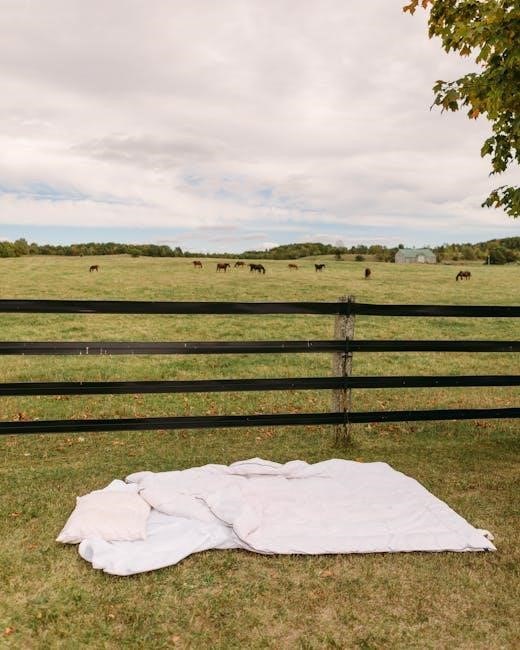
Horse blankets serve multiple vital purposes, primarily shielding horses from cold and extreme weather․ They help maintain a comfortable body temperature, preventing chills and conserving energy, especially during winter․ Blankets are also beneficial for horses that have been clipped, as they lack their natural winter coat․
Furthermore, blankets protect against rain, snow, and wind, preventing horses from becoming soaked and uncomfortable․ This is particularly important for horses living outdoors or those prone to skin issues aggravated by moisture․ Older horses or those with compromised immune systems also benefit from the added warmth and protection blankets provide․
Blankets can also keep horses clean, reducing the amount of grooming needed․ They act as a barrier against mud and dirt, keeping the coat cleaner for longer periods․ Ultimately, using a horse blanket contributes to the horse’s overall health, comfort, and well-being, ensuring they remain happy and healthy․

Factors to Consider When Choosing a Blanket
Selecting the right horse blanket requires careful consideration of several key factors․ Firstly, assess your horse’s living conditions; is your horse stabled, pastured, or both? This will influence the type and weight of blanket needed․ Secondly, consider your horse’s activity level․ Horses in heavy work may require lighter blankets to prevent overheating, while less active horses may need heavier insulation․
Climate plays a crucial role in blanket selection․ In colder regions, heavier blankets with more fill are essential, while milder climates may only require lightweight sheets or blankets․ Additionally, pay attention to your horse’s individual needs․ Older horses, those with health issues, or horses that have been clipped may require different blanket types․
Lastly, ensure a proper fit․ A blanket that is too tight can cause rubbing and discomfort, while one that is too loose can slip and pose a safety hazard․ By carefully evaluating these factors, you can choose a blanket that provides optimal comfort and protection for your horse․
Living Conditions
A horse’s living conditions significantly impact the type of blanket needed․ Horses that primarily live outdoors require durable turnout blankets designed to withstand various weather conditions․ These blankets should be waterproof and breathable to protect against rain, snow, and wind, while allowing moisture to escape․ Consider the presence of shelter; if minimal, a heavier, more protective blanket is necessary․
Conversely, horses primarily stabled may benefit from stable blankets, which are typically less durable but offer warmth and comfort․ Stable blankets are not designed for outdoor use and may not be waterproof․ If a horse spends time both indoors and outdoors, a versatile blanket that can handle both environments is ideal․
Consider the bedding used in the stable․ Deep bedding can provide additional warmth, reducing the need for a heavy blanket․ Regularly check blankets for wear and tear, especially if horses are turned out in groups, as they may be more prone to damage․ Ultimately, tailoring blanket choices to a horse’s specific living situation ensures optimal comfort and protection․
Activity Level
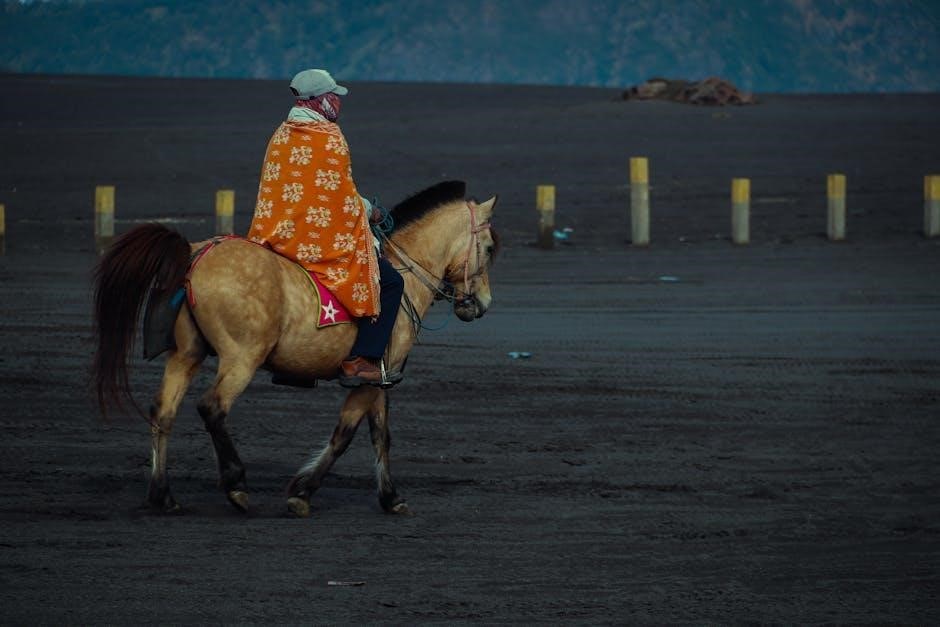
A horse’s activity level is a crucial factor when selecting the appropriate blanket․ Horses engaged in regular training or exercise generate more body heat, requiring blankets that offer breathability and prevent overheating․ During work, consider using a cooler to wick away moisture and regulate temperature, especially in colder months․
For horses with lower activity levels, such as those on stall rest or light work, a warmer blanket may be necessary to maintain body temperature․ Older horses or those with health conditions may also require extra warmth, regardless of activity level․ Monitor your horse’s body condition and adjust blanket thickness accordingly․
Consider the timing of exercise․ If a horse is ridden early in the morning when temperatures are cooler, a lighter blanket might suffice until the workout․ After exercise, ensure the horse is properly cooled down before blanketing to prevent trapping moisture and causing chills․ Choose blankets that accommodate your horse’s specific workload and individual needs․ Regular observation will help determine the most suitable blanket for their activity level․

Climate
Climate plays a pivotal role in determining the type and weight of horse blanket needed․ In regions with harsh winters and sub-freezing temperatures, heavy-weight turnout blankets are essential to protect horses from the cold, wind, and snow․ These blankets typically feature a high fill count for maximum insulation․
In milder climates, a medium-weight or light-weight blanket might suffice․ These blankets provide enough warmth to protect against cool temperatures and rain without causing overheating․ Consider using waterproof and breathable materials to prevent moisture buildup and maintain comfort․
During transitional seasons like spring and fall, fluctuating temperatures require versatile blanket options․ A sheet or a blanket with a detachable neck cover can be beneficial, allowing you to adjust the level of warmth as needed․ Monitoring the weather forecast and making daily adjustments to your horse’s blanketing is crucial for their well-being․ Always prioritize breathability and ensure the blanket fits properly to avoid rubbing or discomfort․ Adapt your blanketing strategy to the specific climate conditions in your area․

Types of Horse Blankets and Sheets
Understanding the different types of horse blankets and sheets is crucial for providing the right level of protection and comfort․ Horse blankets generally have filling to keep your horse warm, whereas sheets are lightweight and may not have any fill at all․ They come in two main varieties: turnout blankets and stable blankets․
Turnout blankets are designed for outdoor use, offering protection from rain, wind, and snow․ They are typically waterproof and durable․ Stable blankets, on the other hand, are intended for indoor use, providing warmth and comfort in the stable․ They are often made from breathable materials․
Horse sheets are lightweight coverings used primarily for keeping horses clean, protecting them from insects, or providing a light layer of warmth․ They can be used alone or as a base layer under heavier blankets․ Consider factors like material, weight, and intended use when selecting the appropriate type of blanket or sheet for your horse’s needs․ Layering is also an option․
Turnout Blankets
Turnout blankets are essential for horses that spend time outdoors, providing crucial protection from the elements․ These blankets are specifically designed to withstand various weather conditions, including rain, wind, and snow․ Constructed from durable, waterproof, and breathable materials, turnout blankets ensure your horse stays dry and comfortable, preventing chills and other weather-related health issues․
These blankets come in various weights, ranging from lightweight options for mild weather to heavyweight options for colder temperatures․ Features to consider include denier (fabric strength), fill weight (insulation), and closure systems (buckles, straps)․ A well-fitted turnout blanket allows freedom of movement while providing complete coverage from withers to tail․
When selecting a turnout blanket, prioritize durability, breathability, and proper fit․ Regular inspection and maintenance are essential to ensure the blanket remains effective and comfortable for your horse․ Proper layering with other blankets may be necessary in extreme cold․
Stable Blankets
Stable blankets are designed specifically for indoor use, providing warmth and comfort to horses housed in stalls․ Unlike turnout blankets, stable blankets are not waterproof or water-resistant, as they are intended for use in a sheltered environment․ These blankets are typically made from breathable materials like quilted cotton or fleece, allowing for good air circulation and preventing overheating․
Stable blankets come in various weights, offering different levels of insulation depending on the stable’s temperature․ They are crucial for maintaining a horse’s body temperature during colder months, especially for clipped horses or those sensitive to drafts․ Proper fit is essential to prevent rubbing and discomfort; blankets should cover the horse’s body from withers to tail without restricting movement․
Regular cleaning and maintenance are necessary to keep stable blankets in good condition․ Ensure the blanket is free from dirt and debris to prevent skin irritation․ While layering is possible, ensure proper breathability to avoid overheating the horse․
Horse Sheets
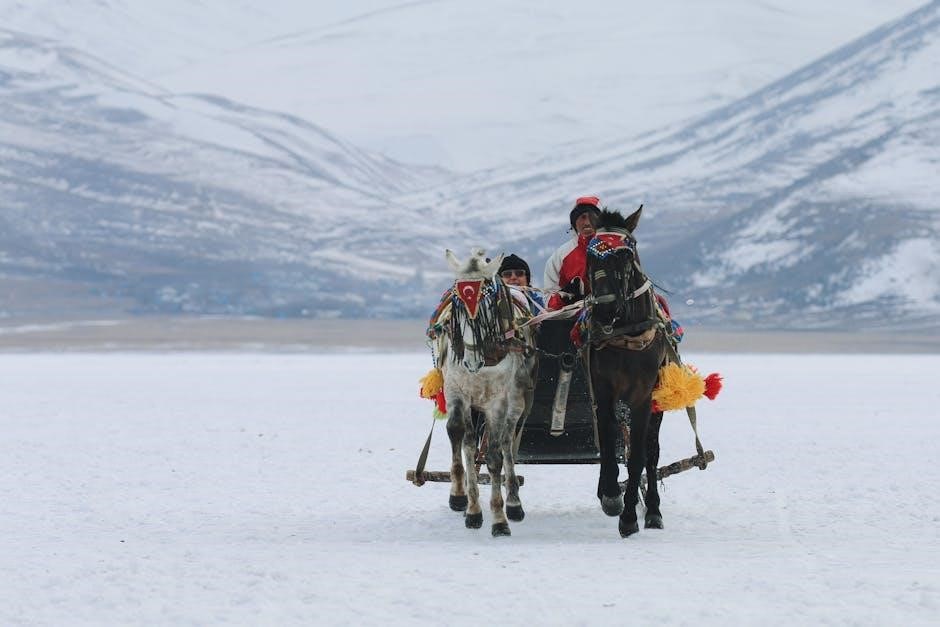
Horse sheets are lightweight coverings used primarily for protection against dust, insects, and light rain․ Unlike blankets, sheets generally lack significant insulation, making them ideal for warmer weather or for layering under heavier blankets․ They are typically made from breathable materials like cotton or nylon, ensuring comfort and preventing overheating․
Horse sheets come in various styles, including those designed for stable use, turnout, and even fly protection․ Stable sheets help keep horses clean in their stalls, while turnout sheets offer minimal protection from the elements during light showers․ Fly sheets, often made of mesh, shield horses from bothersome insects․
Proper fit is crucial to prevent rubbing and ensure the sheet stays in place․ Leg straps and surcingles help secure the sheet without restricting movement․ Regularly check the sheet for any signs of wear and tear and clean it as needed to maintain hygiene․
Fitting a Horse Blanket Properly
Ensuring a proper fit for your horse’s blanket is essential for their comfort and safety․ A poorly fitted blanket can cause rubbing, sores, and even restrict movement․ Start by measuring your horse accurately, from the center of their chest to the farthest point of their rump․ Use this measurement as a guide when selecting a blanket size․
When trying on a blanket, make sure it sits comfortably over the withers without pulling or creating pressure․ The blanket should extend far enough to cover the barrel without being too long, which can cause the horse to step on it․ Check the chest closure for proper adjustment; it should be snug but not restrictive․
Leg straps and surcingles should be adjusted to allow freedom of movement while keeping the blanket securely in place․ Regularly monitor your horse for any signs of rubbing or discomfort, and adjust the blanket as needed․
Measuring Your Horse for a Blanket
Accurately measuring your horse is the first step to ensuring a comfortable and properly fitting blanket․ The most common method involves measuring from the center of the horse’s chest, along their side, to the point of their rump․ Use a flexible measuring tape and have a helper if possible, to keep the horse still and ensure an accurate measurement․
Stand your horse squarely on level ground․ Start the measurement at the center of the chest, where the front of the blanket will typically close․ Extend the tape along the horse’s side, following the natural curve of their barrel, to the farthest point of the rump․
Record the measurement in inches․ This number will correspond to the blanket size you need․ If your measurement falls between sizes, it’s generally recommended to round up to the next larger size to allow for comfortable movement and prevent binding․ Remember that different brands may have slight variations in sizing, so always check the manufacturer’s size chart before making a purchase․
Ensuring Proper Coverage
Once you have a blanket that is theoretically the correct size, ensuring proper coverage is crucial for your horse’s comfort and safety․ The blanket should extend from just in front of the withers to slightly beyond the tail, offering complete protection without being excessively long․ The chest closure should sit comfortably without pulling or restricting movement․
Check the depth of the blanket along the sides․ It should hang low enough to protect the belly but not so low that it interferes with the horse’s legs or movement․ The neckline should fit snugly around the withers, preventing drafts and minimizing the risk of rubbing․
Observe your horse’s movement while wearing the blanket․ Watch for any signs of restriction or discomfort, such as shortened strides or reluctance to move freely․ If the blanket appears too tight in any area, consider trying a larger size or a different style that better accommodates your horse’s conformation․ Remember, a well-fitting blanket allows for natural movement and provides adequate protection without causing irritation․
Adjusting Leg Straps and Surcingles
Proper adjustment of leg straps and surcingles is paramount for a secure and comfortable fit․ Leg straps should be adjusted to allow ample room for movement, typically with a hand’s width of space between the strap and the horse’s leg․ They should cross each other to prevent the blanket from shifting․
Surcingles, or belly straps, should be snug enough to keep the blanket in place but not so tight that they cause discomfort or restrict breathing․ You should be able to easily slide your hand between the surcingles and the horse’s belly․ Unevenly adjusted surcingles can cause the blanket to shift to one side, leading to rubbing and sores․
Regularly inspect the leg straps and surcingles for signs of wear and tear․ Replace any damaged or frayed straps immediately to prevent breakage․ Ensure that all buckles and fasteners are securely fastened to prevent the blanket from coming loose․ Correctly adjusted straps and surcingles are essential for the horse’s safety․
Monitoring and Adjusting Blankets
Regular monitoring and adjustment of horse blankets are crucial for ensuring your horse’s comfort and safety․ Daily checks are recommended to identify any potential issues before they escalate․ Pay close attention to the blanket’s fit, looking for signs of rubbing, pressure points, or areas where the blanket is too tight or too loose․
Check the condition of the blanket itself, including the straps, buckles, and seams․ Repair or replace any damaged components immediately to prevent further problems․ Adjust the blanket as needed based on weather conditions․ If the temperature rises, consider removing a blanket layer or switching to a lighter-weight blanket;
Monitor your horse’s body condition closely․ If your horse appears to be too hot or too cold, adjust the blanket accordingly․ Remember that each horse has different needs, so it is essential to tailor your blanket management to the individual animal․ Consistent observation and timely adjustments contribute significantly to your horse’s overall well-being․
Checking for Rubbing or Discomfort
Regularly checking for rubbing or discomfort caused by horse blankets is vital for your horse’s well-being․ Examine areas prone to friction, such as the withers, chest, shoulders, and hips․ Look for signs of hair loss, skin irritation, or pressure sores․ Run your hands under the blanket to feel for any uneven pressure or bunching that might cause discomfort․
Pay attention to your horse’s behavior․ Signs of discomfort can include excessive scratching, restlessness, or reluctance to move freely․ A blanket that is too tight or ill-fitting can restrict movement and cause soreness․ If you notice any of these signs, remove the blanket immediately and assess the situation․
Ensure that the blanket is clean and free from debris that could irritate the skin․ Adjust the straps and surcingles to achieve a snug but not restrictive fit․ Proper fit is key to preventing rubbing and ensuring your horse remains comfortable while wearing a blanket․
Adjusting Based on Weather Changes

Adapting your horse’s blanketing strategy to changing weather conditions is crucial for their comfort and health․ Monitor the forecast daily and be prepared to adjust blanket weight or remove blankets as needed․ A horse that is too warm can sweat under the blanket, leading to chills when the temperature drops․ Conversely, a horse that is too cold will shiver, indicating they need more insulation․
Consider the combination of temperature, wind, and precipitation when deciding on the appropriate blanket․ A waterproof turnout blanket is essential during rain or snow to prevent your horse from getting soaked․ On milder days, a lighter sheet or no blanket at all might be sufficient․
Pay attention to your horse’s body condition and adjust accordingly․ Horses with thick winter coats may require less blanketing than those with thinner coats․ Regularly check your horse’s temperature to ensure they are neither too hot nor too cold․ Flexibility and responsiveness to weather changes are key to successful blanketing․
Layering Horse Blankets
Layering horse blankets is a versatile strategy for managing your horse’s warmth in fluctuating temperatures․ This approach allows for gradual adjustments, ensuring your horse remains comfortable without overheating or getting chilled․ Start with a lightweight sheet or blanket closest to the horse’s body․ This base layer helps wick away moisture and prevents rubbing․
Add heavier blankets as needed, depending on the temperature․ Ensure each layer fits properly and doesn’t restrict movement․ Regularly check underneath the blankets to assess your horse’s temperature and adjust the layers accordingly․
Layering is particularly useful during transitional seasons when temperatures can vary significantly throughout the day․ By adding or removing layers, you can easily adapt to changing conditions․ Remember to prioritize breathability and avoid over-blanketing, which can lead to discomfort and potential health issues․ Always monitor your horse’s condition and adjust layers as needed for optimal comfort․
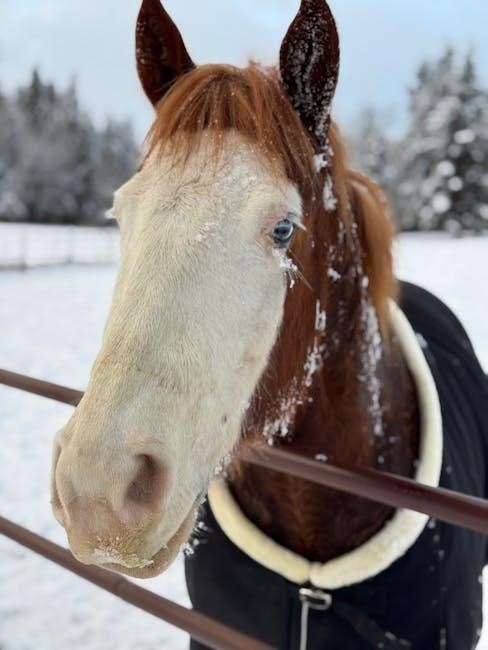
Blanket Straps
Blanket straps are crucial for securing a horse blanket and ensuring a safe, comfortable fit; These straps typically consist of leg straps and surcingles, each serving a distinct purpose․ Leg straps prevent the blanket from shifting excessively, especially during movement․ They should be adjusted to allow adequate freedom of motion without dangling too low, which could pose a tripping hazard․
Surcingles, or belly straps, run underneath the horse’s belly and keep the blanket snugly in place․ These should be adjusted to provide a secure fit without being too tight, which could cause discomfort or restrict breathing․
When adjusting straps, always ensure there is enough room to slide a hand comfortably between the strap and the horse’s body․ Regularly inspect straps for wear and tear, replacing them as needed to maintain optimal functionality․ Proper adjustment of blanket straps is essential for your horse’s safety and comfort․
Selecting the right horse blanket involves careful consideration of several factors, including living conditions, activity level, and climate․ Understanding the different types of blankets, such as turnout and stable blankets, is essential for providing appropriate protection․ Properly fitting a blanket is paramount to prevent rubbing and discomfort․ Regular monitoring and adjustments are necessary to adapt to changing weather conditions and your horse’s individual needs․
Layering blankets can offer additional warmth during colder months․ Paying attention to blanket straps and ensuring they are correctly adjusted is crucial for safety․ By following this comprehensive guide, you can confidently choose and maintain horse blankets, ensuring your equine companion remains comfortable, healthy, and well-protected year-round․ Prioritize your horse’s well-being by implementing these best practices in blanket care and management․